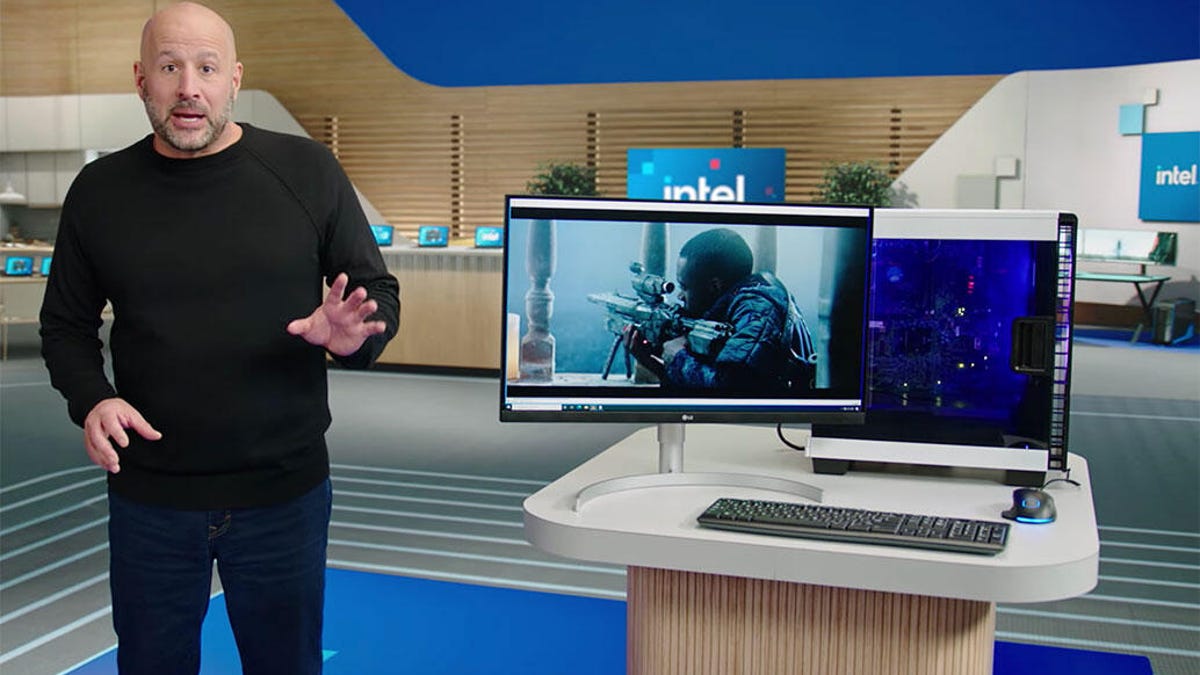Intel shows next-gen Alder Lake laptop chip at CES 2021
The chip should deliver a better blend of performance and battery life -- but Apple's M1 processors already has.

Greg Bryant, leader of Intel's PC chip business, shows a computer running Windows on the next-gen Alder Lake processor at CES 2021.
Intel demonstrated its next-generation flagship laptop chip Monday at CES 2021, a chip code-named Alder Lake that should be faster when you need performance and more power-efficient when you need better battery life. The processor will arrive in the second half of 2021.
The brief demonstration, in an online press conference hosted by Intel's consumer chip leader Greg Bryant, showed Windows running on the new processor. Intel shared almost no details about the chip, but having it up and running is an important step demonstrating that the chip -- and the manufacturing process used to make it -- are maturing. With Intel suffering years of manufacturing problems, that display is more important than usual in telegraphing confidence in the chip.
Alder Lake will arrive in a dramatically different environment than its predecessors, 2019's Ice Lake and 2020's Tiger Lake. Apple is now moving its Mac family off Intel chips in favor of its own M series processors, starting with the M1 in new MacBook Air and smaller MacBook Pro laptops. Those machines are setting new expectations for laptop performance and power. They don't run Windows, but they'll appeal to Apple loyalists and could lure Windows PC owners.
To improve Alder Lake's prospects, Intel turned to a trick used in smartphones and in Apple's M1. It employs power-sipping processing cores for moments when the laptop isn't busy or needs to run low-priority background tasks and faster but more power-hungry cores for moments when performance matters, like gaming or launching a new app.
"It combines high-performance and high-efficiency cores into a single product," Bryant said. "It'll be the foundation for leadership desktop and mobile processors that deliver smarter, faster and more efficient real-world compute usages."
See also
- Our CES 2021 Day 2 recap: Razer's futuristic N95 mask, smart lipstick and a flying car
- CES 2021 products you can actually buy this year
- GM surprises with Cadillac eVTOL air taxi at CES 2021
- ColdSnap is the Keurig of ice cream, and it's a CES 2021 product we all need right about now
- LG Evo at CES: Brighter OLED TVs are finally coming, but they won't come cheap
- CES 2021's coolest new gadgets: Rollable phones, giant TVs, coronavirus killers
A chip that powers both laptops and desktops is important. Intel's most advanced 10th-generation and 11th-generation Core processors only worked in mobile processors. Intel used earlier designs that could crank up to higher clock speeds for machines that are always plugged into a wall power socket.
Intel announced some processors arriving sooner, too. Intel's new 11th-generation H-series processors for superthin gaming laptops should arrive in the first half of the year. Also new are N-series Pentium Silver and Celeron processors for cost-sensitive student laptop market. Notably, these chips are now built with Intel's newest manufacturing process, which can create electronic elements with a width of just 10 billionths of a meter -- 10nm.
Intel's shift from the older 14nm process to the 10nm took place years late and is still going slowly. Alder Lake will use an updated version of the process that offers faster transistors, an important step in matching top speeds of the 14nm process.
Apple doesn't build its own chips, but it's benefited from the abilities of Taiwan Semiconductor Manufacturing Corp., which has marched ahead of Intel with 7nm and now 5nm manufacturing processes. Intel's 10nm is comparable to TSMC's 7nm process, chip analysts say. With the new process's miniaturization advantages, Apple has been able to cram in more and more processing circuitry while Intel has had to reuse existing designs.

